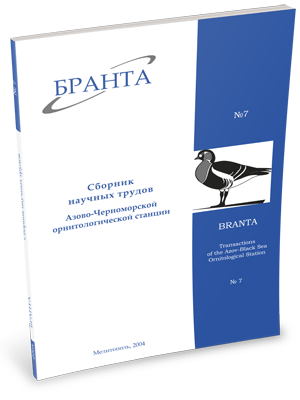
Transactions
of the Azov-Black Sea Ornithological Station



Species composition and numbers of Pelecaniformes and Ciconiiformes in the Dniester Delta
Rusev I.T.
The Dniester river is 1350 km long, including 550 km in Moldova; it has an average flow of 322 m3/s and floods 3 to 11 times a year, which is a key factor to the functioning of the whole ecosystem.
The Dniester delta is situated in the Odessa region and at the northwest coast of the Black Sea. Of the various habitats found within these wetlands, reed-marsh complexes offer the largest area suitable for breeding sites of birds (14000 ha: 63.6%). Continuous reedbeds occupy 5000 ha (22.7%); floodplain forests bordering the Dniester and Turunchuk rivers - 2200 ha (10.0%). Floodplain lakes and oxbows - 3500 ha (15.9%); floodplain meadows - 2000 ha (9.1%). Other types of habitats are of minor importance and are not large enough to support breeding. Reedbeds alternating with reaches and willow shrubs are the most important habitats.
The upper part of the delta belongs to Moldova and is practically reclaimed and transformed into arable lands. As to the lower - Ukrainian part, here one of largest wetlands massive of the Black Sea territory is situated occupying the area of more than 220 km. During 1977-2004 thirteen species were recorded during the breeding period, 2 of which did not breed - Pelecanus crispus and Pelecanus onocrotalus. The highest numbers of breeding birds were recorded for Pelicaniformes and Ciconiiformes - 8662 pairs in 1999 year. Overall, Phalcrocorax carbo (4000 pairs) and Nycticorax nycticorax (1840 pairs) were the most abundant species.
Numbers of Ph.carbo and Ph.pygmeus are increasing. Minor fluctuation in numbers is typical for N.Nycticorax, Egretta alba, Ardea cinerea, Ardea purpurea. Population of Ardeola ralloides, Plegadis falcinellus,Platalea leucorodia are slightly unstable.
Factors influencing number and distribution of birds include: abiotic factors (impact of hydrological regimes and weather conditions), biotic factors (activities of terrestrial predators and birds of prey, negative inter-species relations within breeding colonies) and anthropogenic factors (fishery, fish-breeding, falling of floodplain forests, water contamination with pesticides and chemicals, water intake for irrigation, and grazing).
The Dniester delta is of great value for breeding birds. Significant proportions of the population of P. falcinellus, N.nycticorax, A.ralloides, E.alba, Ph.carbo, Ph.pygmeus breed in the delta area. This area, together with the deltas of the Danube and Dnieper, holds unique breeding bird assemblages for the Azov-Black Sea coast of Ukraine, and is important in regional terms.
Read the paper in a PDF file